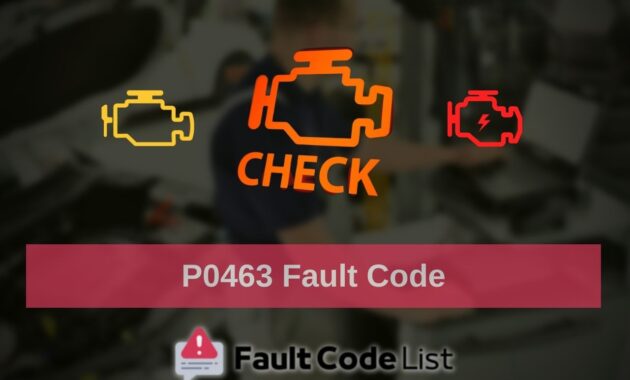Learn about the P0463 fault code and how vehicle’s fuel level sensor works. Discover the symptoms of a faulty fuel level sensor and why the P0463 fault code may appear even when the fuel level is average. Regularly checking the fuel level and being aware of changes in the fuel gauge readings can help vehicle owners maintain their vehicles and avoid potential problems on the road.
The vehicle’s dashboard has a fuel gauge that shows how much fuel is left in the vehicle. A sensor in the fuel tank detects the fuel and sends the information to the vehicle’s brain. The brain then calculates the amount of fuel in the vehicle, which is displayed on the gauge.

If the ECU (Engine Control Unit) generates the P0463 code, the fuel level sensor has detected more fuel in the tank than there is.
How does the fuel level sensor work?
The fuel level sensor is located in the fuel tank and is integrated into the fuel pump module (which is why it is replaced with the fuel pump module). It consists of a float attached to an arm that moves along a resistor connected to a particular grounding circuit.
As the fuel level changes, the float moves up and down, causing the arm to move along the resistor. This changes the resistance of the circuit, which in turn changes the voltage signal sent to the brain. The brain calculates the amount of fuel based on the voltage signal and displays it on the gauge.
If the voltage signal exceeds a certain level (usually the 5-volt limit), the ECU generates the error code P0463, indicating that there is more fuel in the tank than there is.
Error Code P0463 Symptoms
If the ECU generates the P0463, the “Check Engine” light will come on. The fuel gauge may also show a full tank, go beyond the entire line, or show an empty tank.
Why does the P0463 fault code appear even when the fuel level is average?
- The fuel level sensor may be faulty.
- The fuel level sensor may be dislodged.
- There may be corrosion in the fuel tank.
- There may be a problem with the brain.
The P0463 fault code can be a cause for concern for vehicle owners. It can indicate underlying problems with the fuel level sensor, which can lead to inaccurate readings of the amount of fuel in the vehicle. This can cause inconvenience and even danger if the vehicle runs out of fuel unexpectedly.
Knowing how the fuel level sensor works and the symptoms of a faulty fuel level sensor can help vehicle owners diagnose and fix problems with their vehicles. In some cases, the issue may be a simple fix, such as a dislodged sensor or corrosion in the fuel tank. However, if the problem is with the vehicle’s brain, it may require more extensive repairs.
It is essential to regularly check the fuel level and be aware of any changes in the fuel gauge readings to catch problems early on. If the “Check Engine” light comes on, it is important to take the vehicle to a mechanic to diagnose and fix the issue immediately.
Overall, understanding the error code P0463 and the workings of the fuel level sensor can help vehicle owners maintain their vehicles and avoid potential problems on the road.
What is the fuel level sensor?
A: The fuel level sensor is a device that detects the amount of fuel in the vehicle’s fuel tank and sends this information to the vehicle’s brain. The brain then calculates the amount of fuel and displays it on the fuel gauge.
What is the P0463 fault code?
The P0463 fault code is generated by the engine control unit (ECU) when the fuel level sensor detects more fuel in the tank than there is.
What are the symptoms of a faulty fuel level sensor?
The symptoms of a faulty fuel level sensor include a fuel gauge that shows a full tank, goes beyond the entire line, or shows an empty tank. The “Check Engine” light may also come on.
Why might the P0463 fault code appear even when the fuel level is average?
The P0463 fault code might appear when the fuel level is average if there is a problem with the fuel level sensor, such as it being faulty or dislodged. There may also be corrosion in the fuel tank or a problem with the vehicle’s brain.
How can I fix a faulty fuel level sensor?
Fixing a faulty fuel level sensor may involve replacing the sensor or the fuel pump module. In some cases, the issue may be a simple fix, such as a dislodged sensor or corrosion in the fuel tank.
How can I avoid problems with the fuel level sensor?
Regularly checking the fuel level and being aware of any changes in the fuel gauge readings can help vehicle owners maintain their vehicles and avoid potential problems on the road. If the “Check Engine” light comes on, it is important to take the vehicle to a mechanic to diagnose and fix the issue immediately.
